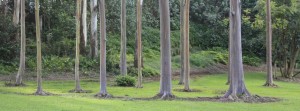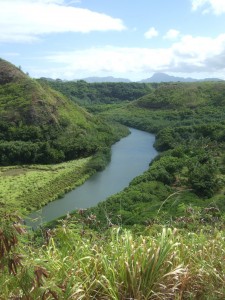 Throughout the islands sacred sites have been preserved, thanks to the efforts of the Hawaiian state park system. While many children may see these ancient places as nothing more than a bunch of rocks, they bear great significance in Hawaiian history.
Throughout the islands sacred sites have been preserved, thanks to the efforts of the Hawaiian state park system. While many children may see these ancient places as nothing more than a bunch of rocks, they bear great significance in Hawaiian history.
Legend claims that Kiki a Ola, or Menehune Ditch, was built in a single night by menehune (legendary small people) to irrigate taro patches for Waimea residents. Today, visitors can still see a two-foot high portion of one of the walls, which extends 25 miles up the Waimea River.
Prince Kuhio Park is the birthplace and home of Prince Jonah Kalanianaole, known as the “People’s Prince” because of his great achievements for the Hawaiian people. See the foundation of the home, royal fishpond and shrine where offerings were made and the heiau (temples or places of worship) where the kahuna (priests) meditated and lived.
Alakoko Fishpond was built for a young chief and once covered 40 acres. Unlike most fishponds built along the coast, this one was designed inland on a river. Today, all that remains is a 13- to 30-foot wall that divides the fishpond from the river.
Kaula Laka Heiau, a sacred altar set among the Na Pali cliffs on the northwest coast of Kauai, was built for Laka, the goddess of hula. It is one of the more dramatic sites on the island with views of the cliffs and ocean.
 Wailua was once home to the island’s royalty. The banks of the Wailua River were sacred in ancient Hawaii and a favorite dwelling place reserved for the kings and high chiefs of Kauai. Near the mouth of the river in Lydgate State Park are the remains of a heiau that was a place of refuge for those who had broken a kapu (taboo). On the river’s north shore are two large pieces of smooth stone, where women of royal blood or high chiefly rank gave birth.
Wailua was once home to the island’s royalty. The banks of the Wailua River were sacred in ancient Hawaii and a favorite dwelling place reserved for the kings and high chiefs of Kauai. Near the mouth of the river in Lydgate State Park are the remains of a heiau that was a place of refuge for those who had broken a kapu (taboo). On the river’s north shore are two large pieces of smooth stone, where women of royal blood or high chiefly rank gave birth.
Nearby is Holoholoku Heiau, believed to be the oldest on the island. Near the Opaeka’a Falls overlook is Poliahu Heiau, a large enclosure of black lava rock that had been the personal temple of Kauai’s last king, Kaumualii. It is believed to have been built by the menehune.

Recent Comments